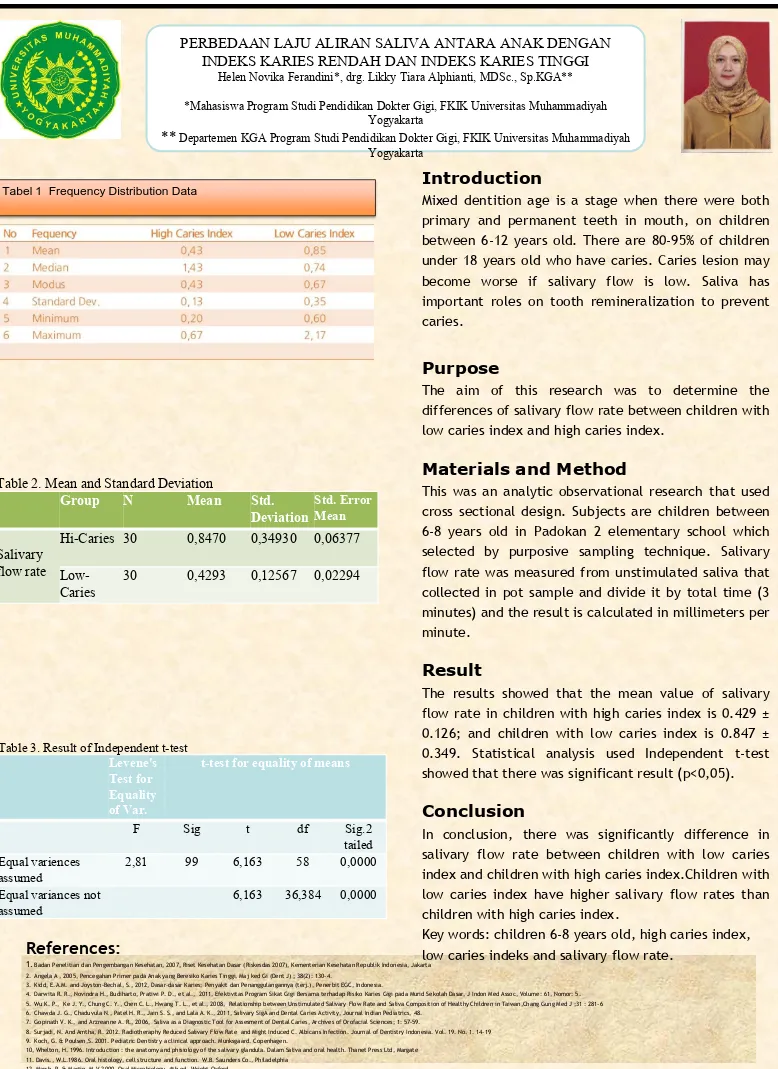References:
1.
Badan Penelitian dan Pengembangan Kesehatan, 2007, Riset Kesehatan Dasar (Riskesdas 2007), Kementerian Kesehatan Republik Indonesia, Jakarta 2. Angela A , 2005, Pencegahan Primer pada Anak yang Beresiko Karies Tinggi, Maj ked Gi (Dent J) ; 38(2): 130-4.3. Kidd, E.A.M. and Joyston-Bechal, S., 2012, Dasar-dasar Karies; Penyakit dan Penanggulangannya (terj.), Penerbit EGC, Indonesia.
4. Darwita R. R., Novindra H., Budiharto, Pratiwi P. D., et al., 2011, Efektivitas Program Sikat Gigi Bersama terhadap Risiko Karies Gigi pada Murid Sekolah Dasar, J Indon Med Assoc, Volume: 61, Nomor: 5. 5. Wu K. P., Ke J. Y., Chung C. Y., Chen C. L., Hwang T. L., et al., 2008, Relationship between Unstimulated Salivary Flow Rate and Saliva Composition of Healthy Children in Taiwan,Chang Gung Med J ;31 : 281-6 6. Chawda J. G., Chaduvula N., Patel H. R., Jain S. S., and Lala A. K., 2011, Salivary SigA and Dental Caries Activity, Journal Indian Pediatrics, 48.
7. Gopinath V. K., and Arzreanne A. R., 2006, Saliva as a Diagnostic Tool for Assesment of Dental Caries, Archives of Orofacial Sciences; 1: 57-59.
8. Surjadi, N. And Amtha, R. 2012. Radiotheraphy Reduced Salivary Flow Rate and Might Induced C. Albicans Infection. Journal of Dentistry Indonesia. Vol. 19. No. 1. 14-19 9. Koch, G. & Poulsen,S. 2001. Pediatric Dentistry a clinical approach. Munksgaard. Copenhagen.
10, Whelton, H. 1996. Introduction : the anatomy and phisiology of the salivary glandula. Dalam Saliva and oral health. Thanet Press Ltd, Margate 11. Davis., W.L.1986. Oral histology, cell structure and function. W.B. Saunders Co., Philadelphia
12. Marsh, P. & Martin, M.V.2000. Oral Microbiology. 4th.ed. Wright.Oxford.
13. Rolla, G., Waller, S.M.& Kjaerheim. 1998. Concept in dental plaque formation. Dalam Oral biofilms and plaque control (Busscher, H.J. & Evans, L.V. eds). Harwood academic publ., switzerland
)
Introduction
Mixed dentition age is a stage when there were both
primary and permanent teeth in mouth, on children
between 6-12 years old. There are 80-95% of children
under 18 years old who have caries. Caries lesion may
become worse if salivary flow is low. Saliva has
important roles on tooth remineralization to prevent
caries.
Purpose
The aim of this research was to determine the
differences of salivary flow rate between children with
low caries index and high caries index.
Materials and Method
This was an analytic observational research that used
cross sectional design. Subjects are children between
6-8 years old in Padokan 2 elementary school which
selected by purposive sampling technique. Salivary
flow rate was measured from unstimulated saliva that
collected in pot sample and divide it by total time (3
minutes) and the result is calculated in millimeters per
minute.
Result
The results showed that the mean value of salivary
flow rate in children with high caries index is 0.429 ±
0.126; and children with low caries index is 0.847 ±
0.349. Statistical analysis used Independent t-test
showed that there was significant result (p<0,05).
Conclusion
In conclusion, there was significantly difference in
salivary flow rate between children with low caries
index and children with high caries index.Children with
low caries index have higher salivary flow rates than
children with high caries index.
[image:1.841.32.810.15.1084.2]Key words: children 6-8 years old, high caries index,
low caries indeks and salivary flow rate.
Tabel 1 Frequency Distribution Data
Table 2. Mean and Standard Deviation
Group
N
Mean
Std.
Deviation
Std. Error
Mean
Salivary
flow rate
Hi-Caries 30
0,8470
0,34930
0,06377
Low-Caries
30
0,4293
0,12567
0,02294
Table 3. Result of Independent t-test
Levene's
Test for
Equality
of Var.
t-test for equality of means
F
Sig
t
df
Sig.2
tailed
Equal variences
assumed
2,81
99
6,163
58
0,0000
Equal variances not
assumed
6,163
36,384
0,0000
PERBEDAAN LAJU ALIRAN SALIVA ANTARA ANAK DENGAN
INDEKS KARIES RENDAH DAN INDEKS KARIES TINGGI
Helen Novika Ferandini*, drg. Likky Tiara Alphianti, MDSc., Sp.KGA**
*Mahasiswa Program Studi Pendidikan Dokter Gigi, FKIK Universitas Muhammadiyah
